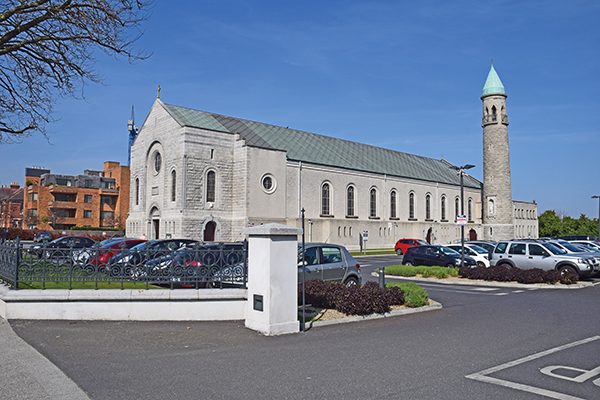
Above: Our Lady Queen of Peace Church in Merrion. Will it be heavily affected by the new Merrion Gates proposals?
Photo by Kevin O’Gorman.
The junction linking Strand Road to Merrion Road and crossing the Dart line in Sandymount is a nuisance at best and a hazard at worst.
Widely known as Merrion Gates, it has been associated with a number of incidents and accidents, with one occurring the last week of February.
A number of proposals have been made over the years to try and alleviate the traffic and congestion as well as the issue with crashing into the gates, which leads to Dart delays at times of heavy traffic.
The current proposal comes out of the Sandymount/Merrion to Blackrock Corridor Study. It proposes diverting traffic from the Strand Road away from the Dart lines through a new junction, which may come down from the Strand Road before this junction. In the view of the NTA, this would alleviate both the acute angle for cyclists as well as avoiding the Dart lines.
NewsFour explained the proposal of the Corridor study in a previous issue. In response to this, we received and interviewed two proposals – one from Bryan O’Flynn and one from Dr. Brian Hughes, who sent in a submission which criticised the proposal and suggested some possible improvements.
Comparing the proposal at Merrion Gates to a similar completed project in the Netherlands, O’Flynn questioned the cost, which he understood to be €48 million. The Netherlands project cost €14.2 million and involved a cycle and car tunnel under the train line to alleviate a congestion issue there. He felt that it would not be “value for money”.
O’Flynn understands that the road alteration will proceed from Strand Road possibly through land owned by local businesses or residential areas but ending up going through the parking spaces of Our Lady of Peace church. This would cause issues for churchgoers, many of whom are elderly.
In addition, the use of Merrion Road at this particular point would mean that an already busy business area would become heavily congested. Considering the area contains St. Vincent’s Hospital, which will also house the National Maternity Hospital, in addition to a number of local businesses.
O’Flynn also stated that it will have an impact on parking for local residents and businesses. He felt that an improved cycle path along the coast was not a strong enough justification and that the Natura 2000 issue impeding access to the bay at the strand was “ridiculous.”
Similarly, Dr Hughes stated: “The NTA needs to accept that people and the human habitat will always take precedence over birds or flora within the concept of proportionality so as to reverse the untenable and unreasonable 2013, EU-foisted 100% ‘freezing’ of Natura [2000] land-areas.”
Therefore, moving into the bay area rather than impacting on people’s houses would prove more productive in terms of road usage. When asked how the congestion issue would be resolved he made reference to the Eastern Bypass, which if underground and overground would be able to alleviate some of the traffic difficulties. As regards the cycling traffic, he felt that, though unpopular, taking away some of the trees along the road may alleviate this issue.
Dr. Hughes, who analysed the proposal in light of broader government planning, as well as in relation to the area surrounding Merrion Gates, felt that the proposal is “disappointingly conservative and unambitious.” He feels that “the journey times between Dun Laoghaire and the city centre are unacceptably long.” This is because of “inadequate transport infrastructure,” given the increased growth and wealth in the area.
He stated that the NTA has perceived obstacles and “appears to be fixated on existing EU SAC judgments, to EU Natura designation, legal and environmental strictures: ones that are not considered by this writer to present impenetrable, unresolvable, or long-term obstacles”.
Dr. Hughes felt that continuing the Strand Road parallel to the railway, “ramping up and crossing the railway immediately north of Booterstown Bird Sanctuary,” then going down the “stream culvert” would link “seamlessly as a slip road onto the Rock Road.” This would allow traffic to be diverted from built up areas and facilitate a single junction on Merrion Road for “local and regional flows, bicycles and pedestrians.”
By Kevin Mac Sharry



